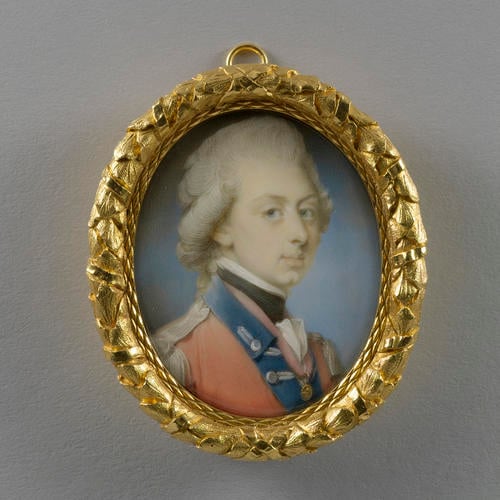-
1 of 253523 objects
Frederick, Duke of York (1763-1827) 1784?
Watercolour on ivory | 4.7 x 3.8 cm (sight) (sight) | RCIN 420950
-
Prince Frederick is wearing the uniform of the Coldstream Guards with the badge of the Order of the Bath on a pink ribbon. The miniature may have been painted to record his coming of age in 1784, the year he was promoted to Lieutenant-General and appointed Colonel of the Coldstream Regiment of Foot Guards and also created Duke of York and Albany.
Frederick (1763-1827), was the second son of George III and Queen Charlotte. In 1791, a marriage was arranged for him with Frederica Charlotte Ulrica Catherina (1767–1820), eldest daughter of Frederick William II, King of Prussia, and his first wife, Elizabeth of Brunswick. In 1798, he was made Commander-in-Chief of the army and helped to introduce a system whereby more men were promoted on merit, rather than through purchase or nepotism. In order to improve the officers' training, he founded the Royal Military Academy, Woolwich, and a military school at High Wycombe which was the forerunner of Sandhurst. Among his innovations were improvements to the style and provision of the clothing of soldiers on active duty. He was popular and jovial – William Thackeray described him as 'big, burly, loud, jolly, courageous, cursing'.
Jeremiah Meyer (1735-89) was born in Germany and his father was portrait painter to the Duke of Württemberg. He came to England about 1749 and studied under the artist Christian Friedrich Zincke. Meyer was commissioned to paint the King's miniature portrait, set in an oval of diamonds in the pearl bracelet given to Princess Charlotte as an engagement present. He also drew the King's profile for the new coinage which earned him a gold medal from the Society of Arts in 1761. He was appointed Miniature Painter to the Queen and Enamel Painter to the King in 1764. A founder member of the Royal Academy, he exhibited miniatures, enamels and watercolour drawings from 1769 to 1783. When he died, according to a contemporary, Charlotte Papendiek, Meyer's widow sent his remaining miniatures, including portraits of the royal family, to the sitters without making a charge. The Queen was so pleased that 'she liberally rewarded Mrs Meyer for her honourable conduct'.
Catalogue entry adapted from Masterpieces in Little: Portrait Miniatures from the Collection of Her Majesty The Queen (1992)Provenance
First recorded in the Royal Collection in 1870
-
Medium and techniques
Watercolour on ivory
Measurements
4.7 x 3.8 cm (sight) (sight)
6.2 x 5.3 cm (frame, external)
Category
Object type(s)
Other number(s)
Cust 1910 : Cust, L., 1910. Windsor Castle: Portrait Miniatures, London – Cust 1910 III/134RL 1870 9.A.2
